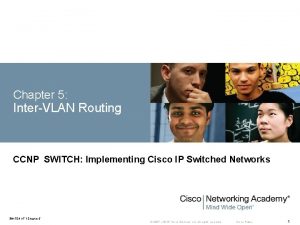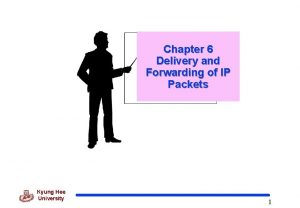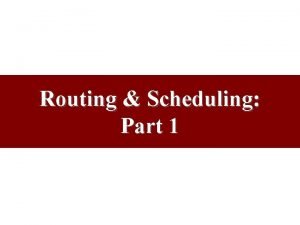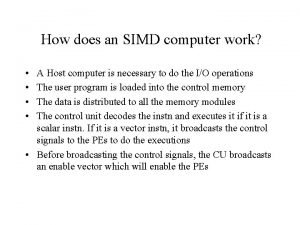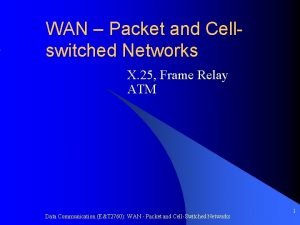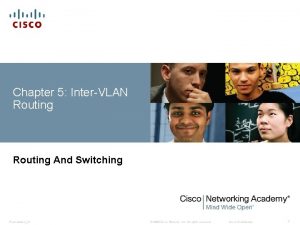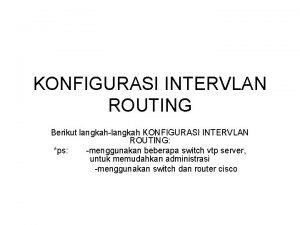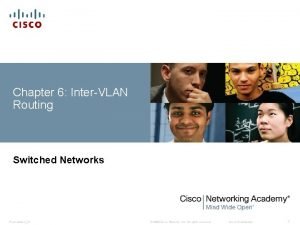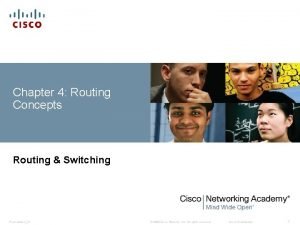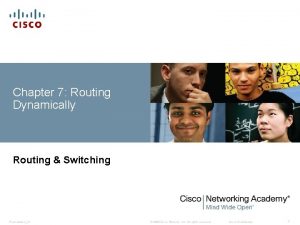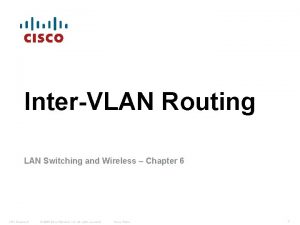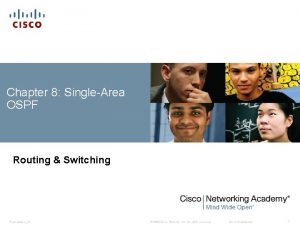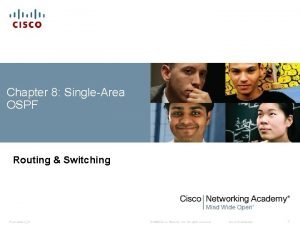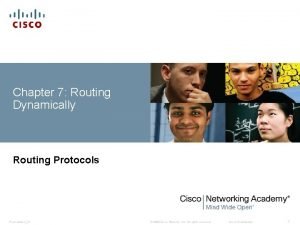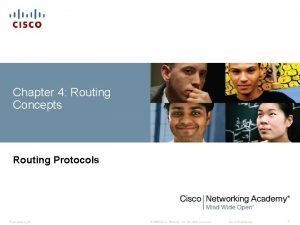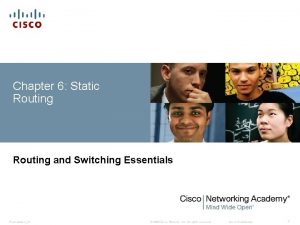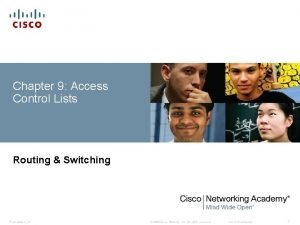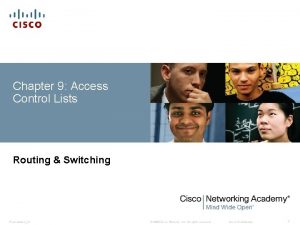Chapter 5 InterVLAN Routing And Switching PresentationID 2008


































- Slides: 34

Chapter 5: Inter-VLAN Routing And Switching Presentation_ID © 2008 Cisco Systems, Inc. All rights reserved. Cisco Confidential 1

Chapter 5 5. 1 Inter-VLAN Routing Configuration 5. 2 Troubleshooting Inter-VLAN Routing 5. 3 Layer 3 Switching 5. 4 Summary Presentation_ID © 2008 Cisco Systems, Inc. All rights reserved. Cisco Confidential 2

Chapter 5: Objectives § Describe three primary options for enabling inter-VLAN routing § Configure legacy inter-VLAN routing § Configure router-on-a-stick inter-VLAN routing § Troubleshoot common inter-VLAN configuration issues § Troubleshoot common IP addressing issues in an inter-VLAN routed environment § Configure inter-VLAN routing using Layer 3 switching § Troubleshoot inter-VLAN routing in a Layer 3 switched environment Presentation_ID © 2008 Cisco Systems, Inc. All rights reserved. Cisco Confidential 3

Inter-VLAN Routing Operation What is Inter-VLAN Routing? § Layer 2 switches can’t forward traffic between VLANs without the assistance of a router § Inter-VLAN routing is a process forwarding network traffic from one VLAN to another using a router Presentation_ID © 2008 Cisco Systems, Inc. All rights reserved. Cisco Confidential 4

Inter-VLAN Routing Operation Legacy Inter-VLAN Routing § In the past, actual routers were used to route between VLAN § Each VLAN was connected to a different physical router interface § Packets would arrive on the router through one through interface, be routed and leave through another § Since the router interfaces were connected to VLANs and had IP addresses from that specific VLAN, routing between VLANs was achieved. § Simple solution but not scalable. Large networks with large number of VLANs would require lots of router interfaces Presentation_ID © 2008 Cisco Systems, Inc. All rights reserved. Cisco Confidential 5

Inter-VLAN Routing Operation Router-On-A-Stick Inter-VLAN Routing § The so called router-on-a-stick approach uses a different path to route between VLANs § One of the router’s physical interfaces is configured as a 802. 1 Q trunk port. Now that interface can understand VLAN tags § Logical subinterfaces are then created. One subinterface per VLAN § Each subinterface is configured with an IP address from the VLAN it represents § VLAN members (hosts) are configured to use the subinterface address as a default gateway. § Only one of the router’s physical interface is used Presentation_ID © 2008 Cisco Systems, Inc. All rights reserved. Cisco Confidential 6

Inter-VLAN Routing Operation Multilayer Switch Inter-VLAN Routing § Multilayer switches can perform Layer 2 and Layer 3 functions. Routers are not required anymore § Each VLAN existent in the switch is a SVI § SVI are seen as layer 3 interfaces § The switch understands network layer PDUs and therefore, it can route between its SVIs just as a router routes between its interfaces § With a multilayer switch, traffic is routed internal to the switch device § Very scalable solution Presentation_ID © 2008 Cisco Systems, Inc. All rights reserved. Cisco Confidential 7

Configure Legacy Inter-VLAN Routing Preparation § Legacy inter-VLAN routing requires routers to have multiple physical interfaces § Each one of the router’s physical interfaces is connected to a unique VLAN § Each interface is also configured with an IP address for the subnet associated with the particular VLAN § Network devices use the router as a gateway to access the devices connected to the other VLANs Presentation_ID © 2008 Cisco Systems, Inc. All rights reserved. Cisco Confidential 8

Configure Legacy Inter-VLAN Routing Preparation Presentation_ID © 2008 Cisco Systems, Inc. All rights reserved. Cisco Confidential 9

Configure Legacy Inter-VLAN Routing Switch Configuration Presentation_ID © 2008 Cisco Systems, Inc. All rights reserved. Cisco Confidential 10

Configure Legacy Inter-VLAN Routing Router Interface Configuration Presentation_ID © 2008 Cisco Systems, Inc. All rights reserved. Cisco Confidential 11

Configure Router-On-A-Stick Preparation § An alternative to legacy inter-VLAN routing is to use VLAN trunking and subinterfaces § VLAN trunking allows a single physical router interface to route traffic for multiple VLANs § The physical interface of the router must be connected to a trunk link on the adjacent switch § On the router, subinterfaces are created for each unique VLAN on the networ § Each subinterface is assigned an IP address specific to its subnet/VLAN and is also configured to tag frames for that VLAN Presentation_ID © 2008 Cisco Systems, Inc. All rights reserved. Cisco Confidential 12

Configure Router-On-A-Stick Switch Configuration Presentation_ID © 2008 Cisco Systems, Inc. All rights reserved. Cisco Confidential 13

Configure Router-On-A-Stick Router Interface Configuration Presentation_ID © 2008 Cisco Systems, Inc. All rights reserved. Cisco Confidential 14

Configure Router-On-A-Stick Verifying Subinterfaces Presentation_ID © 2008 Cisco Systems, Inc. All rights reserved. Cisco Confidential 15

Configure Router-On-A-Stick Verifying Subinterfaces Presentation_ID © 2008 Cisco Systems, Inc. All rights reserved. Cisco Confidential 16

Configure Router-On-A-Stick Verifying Subinterfaces Presentation_ID © 2008 Cisco Systems, Inc. All rights reserved. Cisco Confidential 17

Configure Router-On-A-Stick Verifying Routing § Access to devices on remote VLANs can be tested using the ping command. § The pingcommand sends an ICMP echo request to the destination address § When a host receives an ICMP echo request, it responds with an ICMP echo reply § Tracert is a useful utility for confirming the routed path taken between two devices Presentation_ID © 2008 Cisco Systems, Inc. All rights reserved. Cisco Confidential 18

Inter-VLAN Configuration Issues Switch Port Issues § When using the legacy routing model, ensure that the switch ports that connect to the router interfaces are configured with the correct VLANs § Use the switchport access vlan 10 command to correct any errouneous VLAN port assignment § Also ensure the router is connected to the correct switch port § When using router-on-a-stick, ensure the switch port connected to the router is configured as a trunk link § The switchport mode trunk command can be used to solve this problem Presentation_ID © 2008 Cisco Systems, Inc. All rights reserved. Cisco Confidential 19

Inter-VLAN Configuration Issues Verify Switch Configuration Presentation_ID © 2008 Cisco Systems, Inc. All rights reserved. Cisco Confidential 20

Inter-VLAN Configuration Issues Verify Router Configuration § With router-on-a-stick configurations, a common problem is assigning the wrong VLAN ID to the subinterface § The show interface command can help detecting thi problem § If this is the case, use the encapsulation dot 1 q <vlan id> interface command to fix the problem Presentation_ID © 2008 Cisco Systems, Inc. All rights reserved. Cisco Confidential 21

Inter-VLAN Configuration Issues Verify Router Configuration Presentation_ID © 2008 Cisco Systems, Inc. All rights reserved. Cisco Confidential 22

IP Addressing Issues Errors With IP Address And Subnet Mask § When using legacy inter-VLAN routing, ensure the router has the correct IP address and mask on the interfaces connecting to the switch § Also ensure the network devices are configured with the correct IP address and mask § In the router, the ip address command can be used to fix any erroneous IP assignements § In the PCs, refer to the installed operating system documentation to properly change IP information Presentation_ID © 2008 Cisco Systems, Inc. All rights reserved. Cisco Confidential 23

IP Addressing Issues Verifying IP Address And Subnet Mask Configuration Issues § To verify if the correct IP address is configured in the router, use the show ip interface command § The show running-config can also be useful when troubleshooting router related problems § Although configuring subinterface IDs to match the VLAN number makes it easier to manage inter-VLAN configuration, it is not a requirement. When troubleshooting addressing issues, ensure that the subinterface is configured with the correct address for that VLAN. Presentation_ID © 2008 Cisco Systems, Inc. All rights reserved. Cisco Confidential 24

Layer 3 Switching Operation And Configuration Introduction To Layer 3 Switching § Layer 3 switches usually have packet-switching throughputs in the millions of packets per second (pps) § All Catalyst switches support two types of Layer 3 interfaces: • Routed Port • SVI § High-performance switches, such as the Catalyst 6500 and Catalyst 4500, are able to perform most of the router’s functions § But several models of Catalyst switches require enhanced software for specific routing protocol feature Presentation_ID © 2008 Cisco Systems, Inc. All rights reserved. Cisco Confidential 25

Layer 3 Switching Operation And Configuration Inter-VLAN Routing with SVIs § Today routing has become faster and cheaper and can performed at hardware speed § It can be transferred to core and distribution devices with little to no impact on network performance § Many users are in separate VLANs, and each VLAN is usually a separate subnet § This implies that each distribution switch must have IP addresses matching each access switch VLAN § Layer 3 (routed) ports are normally implemented between the distribution and the core layer § This model is less dependent on spanning-tree as there are no loops in the Layer 2 portion of the topology Presentation_ID © 2008 Cisco Systems, Inc. All rights reserved. Cisco Confidential 26

Layer 3 Switching Operation And Configuration Inter-VLAN Routing with SVIs (cont) § By default, an SVI is created for the default VLAN (VLAN 1). This allows for remote switch administration § Any additional SVIs must be created by the admin § SVIs are created the first time the VLAN interface configuration mode is entered for a particular VLAN SVI § The interface vlan 10 entered by the first time creates an SVI named VLAN 10 § The VLAN number used corresponds to the VLAN tag associated with data frames on an 802. 1 Q encapsulated trunk § Whenever the SVI is created, ensure that particular VLAN is present in the VLAN database Presentation_ID © 2008 Cisco Systems, Inc. All rights reserved. Cisco Confidential 27

Layer 3 Switching Operation And Configuration Inter-VLAN Routing with SVIs (cont) § SVIs advantages include: • It is much faster than router-on-a-stick, because everything is hardware switched and routed. • No need for external links from the switch to the router for routing. • Not limited to one link. Layer 2 Ether. Channels can be used between the switches to get more bandwidth. • Latency is much lower, because it does not need to leave the switch. Presentation_ID © 2008 Cisco Systems, Inc. All rights reserved. Cisco Confidential 28

Layer 3 Switching Operation And Configuration Inter-VLAN Routing with Routed Ports § A routed port is a physical port that acts similarly to an interface on a router § Routed ports are not associated with any VLANs § Layer 2 protocols, such as STP, do not function on a routed interfac § Routed ports on a Cisco IOS switch do not support subinterfaces § To configure routed ports, use the no switchport interface configuration mode command § Note: Routed ports are not supported on Catalyst 2960 Series switches. Presentation_ID © 2008 Cisco Systems, Inc. All rights reserved. Cisco Confidential 29

Layer 3 Switching Operation And Configuration Configuring Static Routes on a Cat 2960 § The Cisco Switch Database Manager (SDM) provides multiple templates for the 2960 switch § The sdm lanbase-routingtemplate can be enabled to allow the switch to route between VLANs and to support static routing § Use the show sdm prefer command verify which template is in use § The SDM template can be changed in global configuration mode with the sdm prefer command Presentation_ID © 2008 Cisco Systems, Inc. All rights reserved. Cisco Confidential 30

Troubleshooting Layer 3 Switching Configuration Issues § To troubleshoot Layer 3 switching issues, check the following items for accuracy: § VLANs • VLANs must be defined across all the switches • VLANs must be enabled on the trunk ports • Ports must be in the right VLANs § SVIs • SVI must have the correct IP address or subnet mask • SVI must be up • SVI must match with the VLAN number Presentation_ID © 2008 Cisco Systems, Inc. All rights reserved. Cisco Confidential 31

Troubleshooting Layer 3 Switching Configuration Issues § To troubleshoot Layer 3 switching issues, check the following items for accuracy (cont): § Routing • Routing must be enabled • Each interface or network should be added to the routing protocol § Hosts • Hosts must have the correct IP address or subnet mask • Hosts must have a default gateway associated with an SVI or routed port Presentation_ID © 2008 Cisco Systems, Inc. All rights reserved. Cisco Confidential 32

Chapter 5: Summary § This chapter covered Inter-VLAN routing, the process of routing traffic between different VLANs, using either a dedicated router or a multilayer switch. § It discussed Legacy, router-on-a-stick and multilayer swtiching inter-VLAN routing. § The chapter also covers Layer 3 switching, SVIs and routed ports. § Lastly, troubleshooting inter-VLAN routing with a router or a Layer 3 switch were discussed. Common errors involve VLAN, trunk, Layer 3 interface, and IP address configurations. Presentation_ID © 2008 Cisco Systems, Inc. All rights reserved. Cisco Confidential 33

Presentation_ID © 2008 Cisco Systems, Inc. All rights reserved. Cisco Confidential 34
 Cisco intervlan routing
Cisco intervlan routing Circuit switching vs packet switching vs message switching
Circuit switching vs packet switching vs message switching Comparison of virtual circuit and datagram networks
Comparison of virtual circuit and datagram networks Packet switched network vs circuit switched
Packet switched network vs circuit switched Routing and switching
Routing and switching Routing and switching
Routing and switching Routing and switching protocols
Routing and switching protocols Routing and switching protocols
Routing and switching protocols Cell switching vs packet switching
Cell switching vs packet switching Packet switching vs circuit switching
Packet switching vs circuit switching Cell switching vs packet switching
Cell switching vs packet switching Reservoir routing and channel routing
Reservoir routing and channel routing Mark tinka
Mark tinka Continuity equation hydrology
Continuity equation hydrology Clock and power routing in vlsi
Clock and power routing in vlsi Routing switching adalah
Routing switching adalah 2008 2008
2008 2008 Code mixing examples
Code mixing examples Switching overvoltages in ehv and uhv systems
Switching overvoltages in ehv and uhv systems Lan switching and wireless
Lan switching and wireless Optical switching and networking
Optical switching and networking Ortec routing and dispatch
Ortec routing and dispatch Interplay between routing and forwarding
Interplay between routing and forwarding Delivery and routing of ip packets
Delivery and routing of ip packets Principles of good routing and scheduling
Principles of good routing and scheduling Rip static
Rip static Advantages of link state routing vs distance vector
Advantages of link state routing vs distance vector Masking and data routing mechanism
Masking and data routing mechanism Lab 4-1: routing concepts and protocols
Lab 4-1: routing concepts and protocols Broadcast and multicast routing
Broadcast and multicast routing Wan packet switching
Wan packet switching Teknik switching
Teknik switching Benes network
Benes network Template switching
Template switching Label switch router
Label switch router
